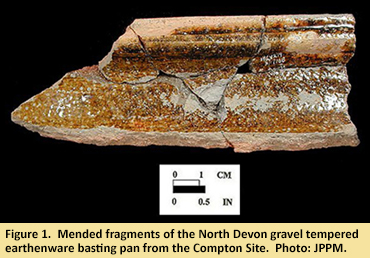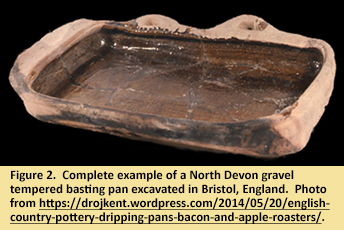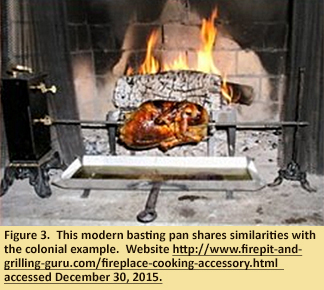Curator's Choice 2016
Roast Turkey; Seventeenth-Century Style
January 2016
By Patricia Samford, MAC Lab Director
 With Thanksgiving and Christmas just behind us and the long winter ahead, ‘tis the time of year for roast turkey and other savory joints of meat. This month’s artifact would have come in very handy for the seventeenth-century cook seeking to prepare a succulent wild turkey, a species common in colonial Maryland’s forests.
With Thanksgiving and Christmas just behind us and the long winter ahead, ‘tis the time of year for roast turkey and other savory joints of meat. This month’s artifact would have come in very handy for the seventeenth-century cook seeking to prepare a succulent wild turkey, a species common in colonial Maryland’s forests.
The mended coarse earthenware fragments are part of the rim and base of a North Devon gravel tempered basting pan. This vessel form is not one typically found in colonial archaeological assemblages, and in fact, it took staff here at the lab awhile to figure out what it was. A complete example was discovered during early excavations at Jamestown Island (Watkins 1960) and more recent work in Bristol, England revealed the example shown in Figure 2. The flat, shallow pan, placed under a bird or joint of meat being spit roasted during open hearth cooking, caught the juices that dripped from the cooking meat. These juices were used to baste the meat and to later prepare gravies.
 This vessel is from the Compton Site (18CV279), a mid-17th-century tobacco plantation located along the Patuxent River in Calvert County, Maryland. William and Magdalen Stevens lived and worked at this plantation from 1651 until the mid-1660s. Archaeological excavations at the Compton Site showed that the Stevens family relied on a number of wild and domestic meats, including chicken, goat, pig, cow, horse, deer, raccoon, opossum and turtle (Louis Berger 1989). In preparing roasted turkey, perhaps Magdalen Stevens followed the wisdom of Gervase Markham in the English Housewife, a popular household guide published in 1615:
This vessel is from the Compton Site (18CV279), a mid-17th-century tobacco plantation located along the Patuxent River in Calvert County, Maryland. William and Magdalen Stevens lived and worked at this plantation from 1651 until the mid-1660s. Archaeological excavations at the Compton Site showed that the Stevens family relied on a number of wild and domestic meats, including chicken, goat, pig, cow, horse, deer, raccoon, opossum and turtle (Louis Berger 1989). In preparing roasted turkey, perhaps Magdalen Stevens followed the wisdom of Gervase Markham in the English Housewife, a popular household guide published in 1615:
“Sauce for a Turkey Take fair water, and set it over the fire, then slice good store of Onions, and put into it, and also Pepper and Salt and good store of Gravy that comes from the Turkey, and boyl them very well together: then put to it a few fine crums of grated bread to thicken it, a very little Sugar, and some Venegar, and so serve it up with the Turkey” (Markham 1994: 92). |
 Markham discusses roasting a wide variety of meats in great detail in his guide; interestingly, he does not mention using a basting pan in any of his directions. Although we may not find them often on archaeological sites, it is likely that every seventeenth-century housewife knew what they were!
Markham discusses roasting a wide variety of meats in great detail in his guide; interestingly, he does not mention using a basting pan in any of his directions. Although we may not find them often on archaeological sites, it is likely that every seventeenth-century housewife knew what they were!
| References |
|
| Louis Berger and Associates, Inc. |
| 1989 |
The Compton Site, circa 1651-1684, Calvert County, Maryland, 18CV279. Report prepared for CRJ Associates, Inc., Camp Springs, Maryland, 1989. |
|
| Kent, Oliver |
|
"English Country Pottery - dripping pans, bacon and apple roasters". Clay and Fire. May 20, 2014. Website https://drojkent.
wordpress.com/2014/05/20/english-country-pottery-dripping-pans-bacon-and-apple-roasters/ accessed December 29, 2015. |
|
| Markham, Gervase |
| 1994 |
The English Housewife. Edited by Michael Best. McGill-Queen’s University Press, 1994. Originally published as Countrey Contentments, or, The English Huswife. Hannah Sawbridge, London, 1615 |
|
| Watkins, C. Malcolm |
| 1960 |
North Devon pottery and its Export to America in the 17th Century. Bulletin 225, United States National Museum, Washington, D.C. 1960. |
|
|
|
|
|